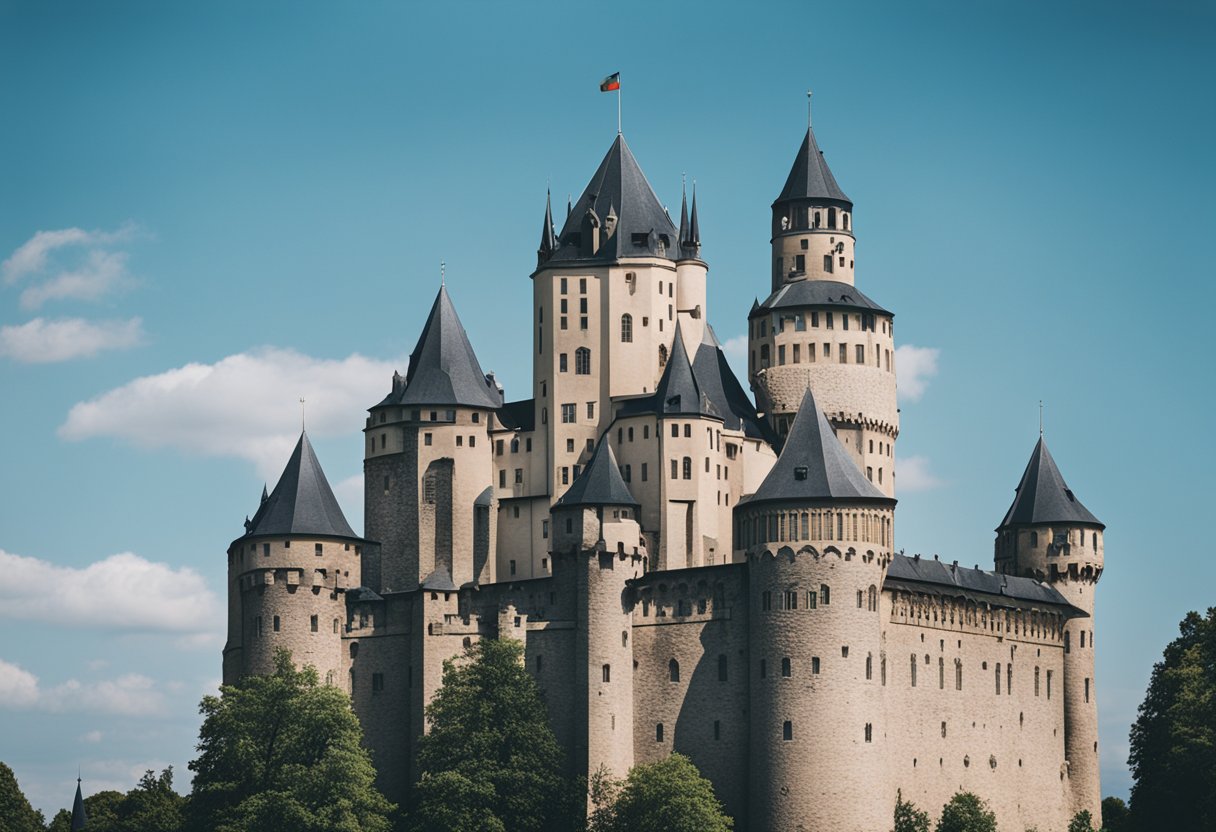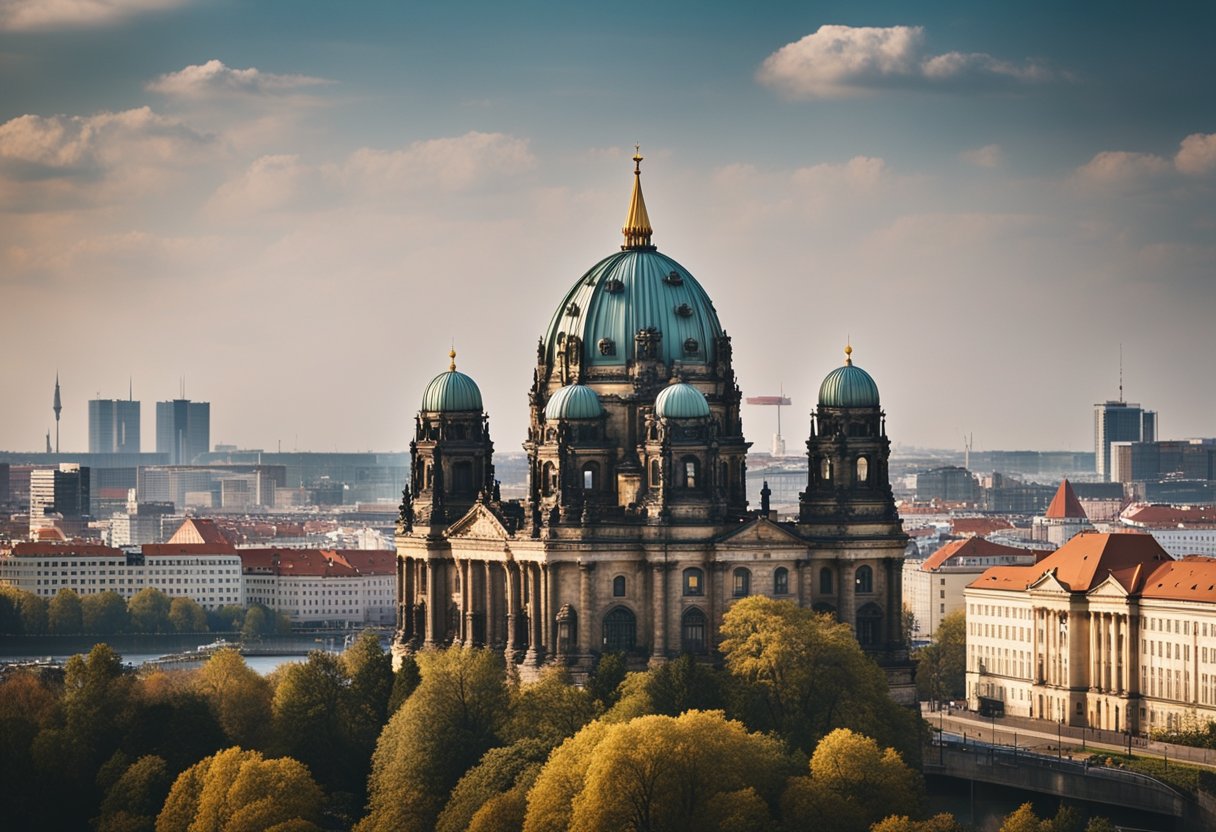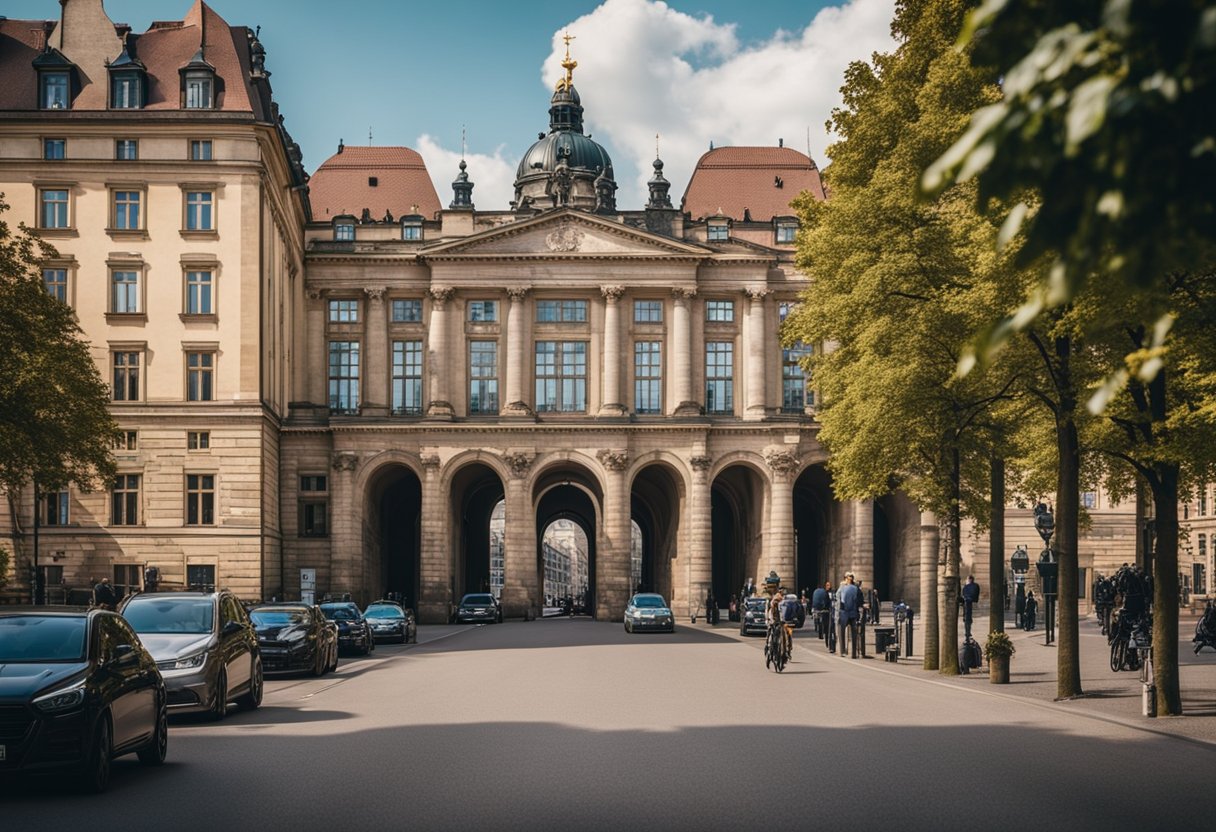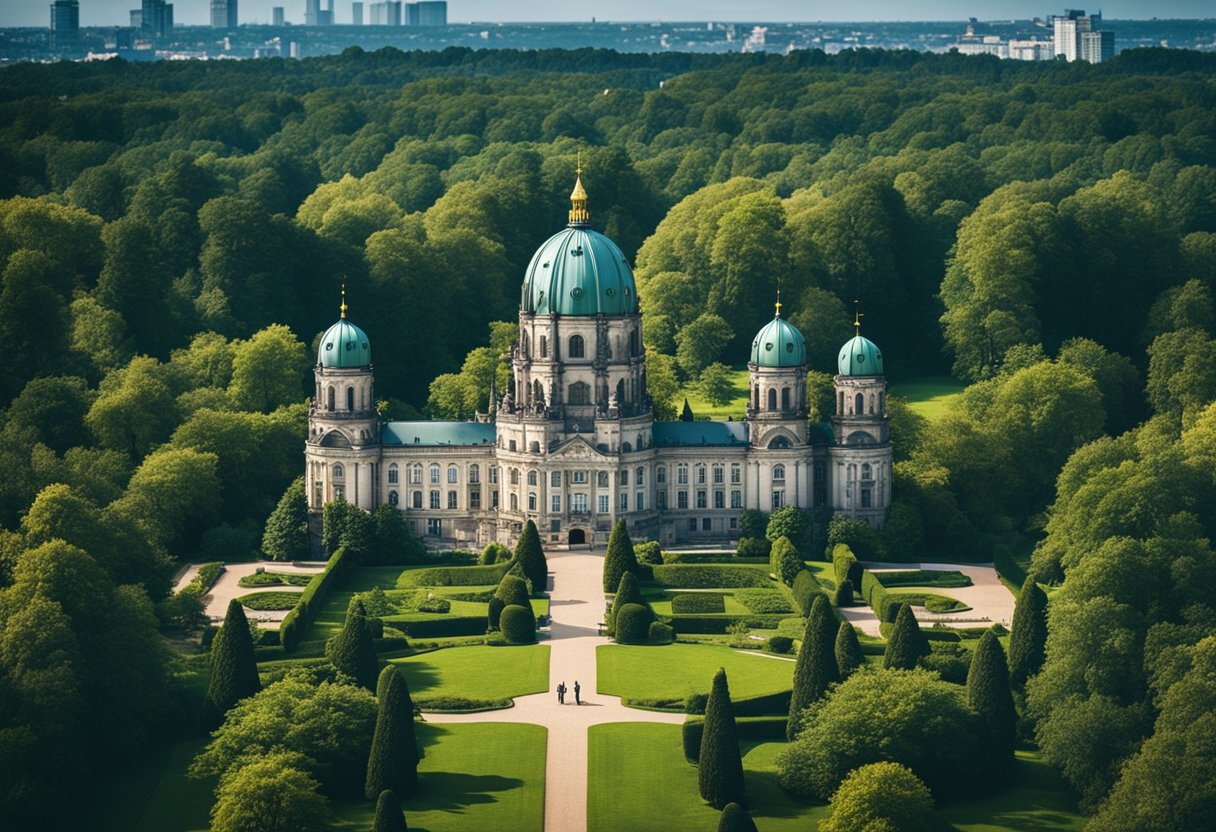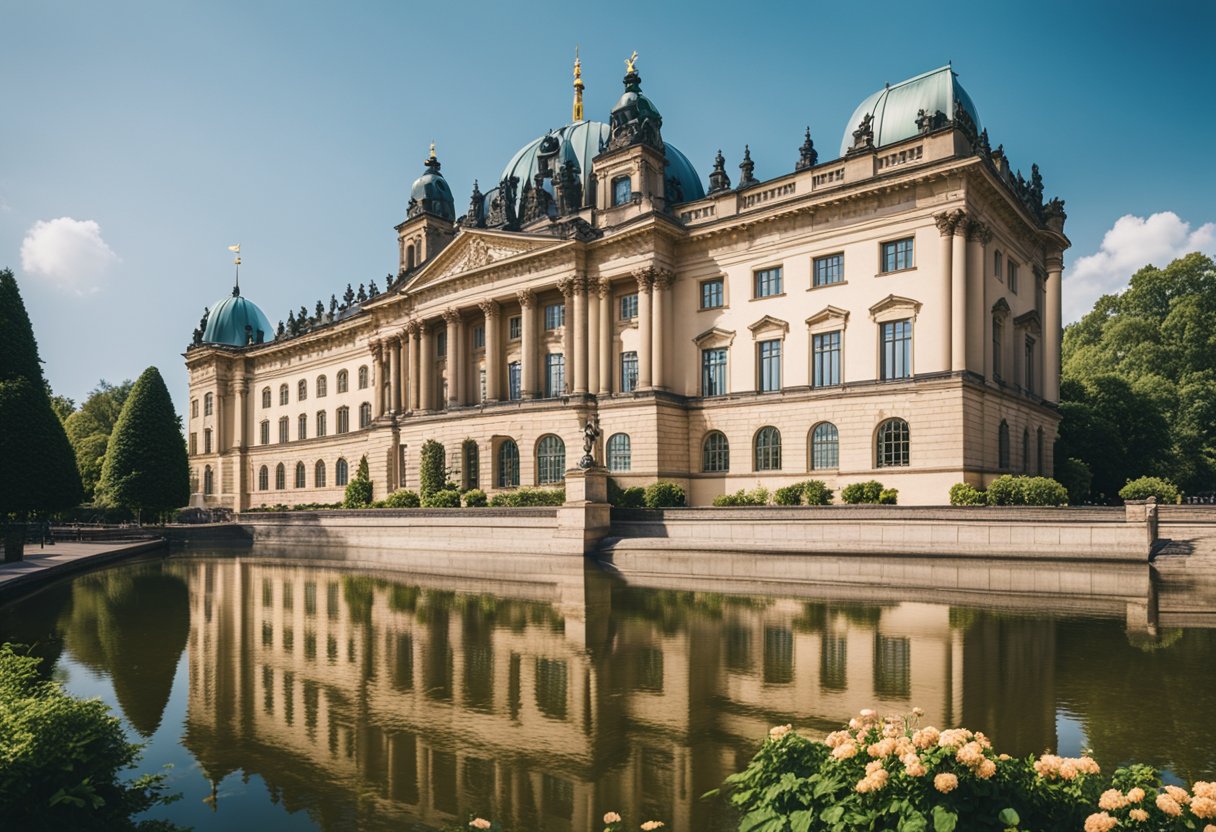Berlin, the capital city of Germany, is a treasure trove of historical architecture, telling the tales of a rich and complex history.
Among the urban landscape of this European metropolis, numerous castles in Berlin Germany stand as a testament to the region’s royal past.
These castles, each with their unique design and history, offer visitors a glimpse into the grandeur and political significance of Berlin’s erstwhile monarchy.
While the exact number of castles in Berlin Germany is subject to various classifications, the city and the surrounding region of Brandenburg are known for their substantial collection of historic forts, palaces, and manors.
One prominent example is Charlottenburg Palace, renowned for its baroque and rococo styles, sprawling gardens, and rich interiors.
This palace serves as a cultural highlight and a major attraction for anyone interested in Berlin’s royal heritage.
In stark contrast to Charlottenburg’s preserved beauty, remnants of history are also visible in the form of abandoned castles, like the ruins of the Schloss Biesdorf, that showcase a different aspect of Berlin’s architectural narrative.
The city’s royal palaces, having endured the test of time and history, including the destruction of the Stadtschloss, Berlin’s original Royal Palace, offer a fascinating journey through the ages for history buffs and casual visitors alike.
Venturing outside the city’s bounds, the castles near Berlin share this historical richness.
They pepper the Brandenburg countryside, each castle telling a unique story of Germany’s past, from medieval times to the splendors of the Prussian kingdom.
These castles not only enhance our understanding of German history but also contribute to the cultural and architectural diversity that Europe is known for.
They provide a picturesque escape into the times when kings and queens walked their halls, and they continue to be an integral part of Berlin’s identity today.
History of Castles in Berlin Germany
Berlin’s castles embody the city’s eventful history, from medieval strongholds and palaces of Prussian kings to the tumultuous events of World War II and their subsequent restoration.
Early Foundations and Middle Ages
Castles in Berlin Germany began primarily as medieval forts intended for defense and as symbols of power.
The Spandau Citadel, one of Berlin’s most important medieval sites, was originally built in the 10th century. It served as a protective barrier for the trade routes along the rivers Havel and Spree.
Prussian Kings and German Emperors
During the height of Prussian power, numerous palaces were built in and around Berlin. The Charlottenburg Palace, constructed at the end of the 17th century, was a magnificent summer residence for Sophie Charlotte, Queen Consort of Prussia.
The Berlin Palace, also known as the Berliner Schloss, became the main residence of the House of Hohenzollern, the lineage that included many Prussian kings and German emperors.
World War II Impact
The Nazi era and World War II had a profound effect on Berlin’s historic structures. Many castles were damaged or destroyed, including the Berlin Palace, which faced significant devastation during air raids and subsequent battles in the city.
Post-War and Restoration
After the war, many castles underwent extensive reconstruction to repair the war’s damage. For instance, the Berliner Schloss is undergoing a modern rebuild to revive its historical grandeur.
Restoration efforts reflect Berlin’s commitment to preserving its cultural heritage despite past destruction.
Major Palaces and Castles in Berlin Germany
Berlin, with its rich historical tapestry, is home to some of the most significant and storied castles and palaces in Germany. These structures, ranging from royal residences to fortified structures, are key to understanding the city’s past and present.
Charlottenburg Palace
Charlottenburg Palace, Berlin’s largest and most celebrated palace, serves as a stunning example of the city’s Baroque architecture.
Constructed at the end of the 17th century, it was initially a summer residence but has since witnessed the influence of several Prussian kings as well as German emperors.
The palace grounds and its opulent interior, which include the famous Porcelain Cabinet and the Orangery, are a magnet for visitors and enthusiasts of royal history.
Bellevue Palace
As the official residence of the President of Germany, Bellevue Palace holds a unique place in the country’s political landscape.
It stands with grace near Berlin’s Tiergarten Park, offering a neoclassical design that dates back to the 18th century.
Despite serving as a modern political landmark, it allows the public to delve into Germany’s past with its architectural grandeur.
Spandau Citadel
The Spandau Citadel, known as Zitadelle Spandau in German, is a fortress that takes visitors back to the Renaissance era. It is one of the oldest surviving fortresses in Berlin, playing a critical role in the city’s defense over the centuries.
Today, it attracts visitors with its historical exhibitions and open-air concerts, standing as a testament to Berlin’s resilience and strategic importance.
Pfaueninsel (Peacock Island)
Situated in the River Havel is Pfaueninsel, a UNESCO World Heritage Site that offers more than just scenic beauty. Named after the peacocks that roam the island, it features a romantic castle built in the 19th century.
This island and its castle are often celebrated for their picturesque landscape gardens, which provide a charming escape from the urban bustle of Berlin.
Glienicke Palace
With its remarkable neoclassical design, Glienicke Palace sits at the edge of Berlin, near the city of Potsdam. It was once the summer residence of Prince Carl of Prussia, and it beautifully reflects the classical Italian villas.
The palace and its adjoining park are part of the “Palaces and Parks of Potsdam and Berlin” UNESCO World Heritage Site, emphasizing the interconnected cultural landscape shared with Berlin’s surroundings.
Architectural Styles and Influences
The architectural landscape of Berlin reflects a diverse historical narrative, where each style marks a distinct era. This richness in architectural tapestry is especially evident in the city’s castles and palatial structures.
Baroque and Rococo Influences
Berlin’s castles exhibit the grandeur of Baroque and Rococo styles, with Schloss Charlottenburg as a prime example. This baroque palace, built at the end of the 17th century, captivates with its elaborate decorations and opulent furnishings.
The Rococo influence is most notable in the interiors—a spatial art of ornate plasterwork and intricate designs, truly reflecting a period focused on aesthetics and courtly splendor.
Classical and Renaissance Revival
The Marble Palace (Marmorpalais) in Potsdam near Berlin is a testament to the embrace of Classical and Renaissance Revival styles.
Designed by architect Carl Gotthard Langhans, the neoclassical elegance of the early 19th century shines through the use of fine materials, including the marble that gives the palace its name, and a clear adherence to symmetry and proportion that were foundational to Renaissance ideals.
Modern Reconstructions
Berlin’s castles also underwent significant transformations through modern reconstructions. The iconic Berliner Schloss, originally constructed in the 15th century, was heavily damaged during World War II and later demolished.
Its recent reconstruction, completed in the 21st century, exemplifies how historical architecture can be revitalized through modern techniques while preserving the essence of its stylistic origins.
Many of these historical structures, including architectural buildings envisioned by Karl Friedrich Schinkel, still stand today as monuments of cultural significance, narrating a journey through time from medieval fortresses to the regality of Baroque palaces and the rebirth through modern reconstruction.
As for the structures no longer standing, like the abandoned castles in Berlin Germany, they are remembered through historical accounts and inspire the city’s ongoing dialogue with its architectural past.
Gardens, Parks, and Natural Landscapes
In Berlin, Germany, the grandeur of historical castles extends into their magnificent gardens and parks. These verdant spaces showcase the fusion of nature, art, and history that has been meticulously preserved for public enjoyment and cultural enrichment.
Sanssouci Park and Gardens
Sanssouci Park, situated in Potsdam, near Berlin, is a prime example of garden art from the 18th century.
This expansive park, once the summer palace of Frederick the Great, King of Prussia, is renowned for its terraced gardens and the impressive Sanssouci Palace.
The park’s layout is a testament to the era’s taste for baroque garden design and includes a myriad of sculptures, fountains, and a large orangerie.
Glienicke Palace Gardens
At the southwestern edge of Berlin lies the Glienicke Palace Gardens, a UNESCO World Heritage site designed in the 19th century by the famous garden artist Peter Joseph Lenné.
The park’s layout perfectly integrates with the palatial architecture and features classically styled landscaped gardens that extend to the banks of the Havel River, offering a picturesque setting that echoes the grandeur of bygone eras.
Charlottenburg Palace Garden
The Charlottenburg Palace Garden is a splendid example of Baroque and Rococo landscape gardening. It surrounds the Charlottenburg Palace, Berlin’s largest and most significant palace, which served as a royal residence to the Hohenzollern family.
Present-day visitors can stroll through the elaborately designed garden that offers a serene escape with its geometric pathways, ornate statues, and beautifully arranged flower beds.
Touring Palaces and Castles in Berlin Germany
Berlin, renowned for its historical significance and architectural marvels, boasts a number of castles and palaces that reflect the city’s regal past.
Visitors can explore these historic sites through various guided tours, appreciate them via accessible public transportation, and even attend special events and concerts.
Guided Tours and Audio Guides
Guided tours offer travelers an in-depth experience of Berlin’s storied castles and palaces. For example, a guided tour of the Potsdam Sanssouci Palace includes bus transport, enriching the educational aspect with comfort and convenience.
Meanwhile, audio guides are available at sites like the Charlottenburg Palace, allowing visitors to discover the castle’s history at their own pace.
Public Transportation Accessibility
Berlin’s efficient public transportation system makes visiting castles and palaces a breeze.
For instance, Charlottenburg Palace is easily reachable by both bus and train, ensuring that even the palaces located just outside of Berlin are within an arm’s reach.
Timetables and routes can be easily found and navigated, with the proximity of train and bus stops to the castles minimizing travel time and maximizing exploration.
Events and Concerts at the Palaces
The palaces in Berlin often serve as grand backdrops for special events and concerts, adding a layer of cultural immersion to the experience.
The Charlottenburg Palace, for instance, hosts elegant dinners accompanied by classical concerts from the Berlin Residence Orchestra. These events provide an opportunity to enjoy Berlin’s royal heritage in an interactive and memorable way.
Cultural Significance and UNESCO Sites
Berlin’s historical backdrop is prominently featured through its castles and palaces, some of which are recognized as UNESCO World Heritage Sites.
These landmarks not only recount a past of royal opulence but also serve as pivotal cultural repositories, hosting art exhibitions and safeguarding historic collections.
Art Exhibitions and Historic Collections
Schloss Charlottenburg stands out as not just a historical edifice but also a cultural venue boasting Staatliche Museen zu Berlin managed art collections.
Visitors to the palace encounter firsthand the grandeur of Rococo-style interiors and can explore a plethora of artworks that once were deemed degenerate art during tumultuous periods of the city’s history.
Despite damages sustained in World War II, this edifice has been restored and continues to offer exhibitions that encapsulate a spectrum of artistic and historical narratives.
UNESCO World Heritage Status
Berlin is graced with UNESCO World Heritage Sites such as the palaces and parks of Potsdam and Berlin, an ensemble illustrating the grandeur and vision of Prussian kings.
Charlottenburg Palace, along with the picturesque Peacock Island, home to its fairytale-like castle, exemplifies the fusion of art and nature that garnered world heritage acknowledgment.
The meticulous restoration of these sites underscores their global cultural significance and aids in preserving the tangible links to the city’s regal heritage.
The Roles of Castles in Berlin Germany Today
Berlin’s castles, steeped in history, have transitioned into symbols of cultural heritage and serve functional roles in the modern era, from hosting state events to enlightening visitors as museums.
Official Residences and State Functions
Schloss Bellevue is the primary official residence of the German President. It hosts important state ceremonies and acts as a venue for presidential activities.
Sanssouci Palace, once the summer palace of Frederick the Great, is now used for state receptions and official events, showcasing the legacy of the Hohenzollerns.
Museums and Public Spaces
Berliner Schloss, reconstructed as the Humboldt Forum, serves as a museum and public event space. It reflects the grandeur of the city’s royal past while inviting the public to engage with both the historical and contemporary cultural displays.
Charlottenburg Palace, with its Baroque and Rococo décor, has been transformed into a museum that offers visitors insights into the luxurious lives of Prussian royalty, complemented by its well-manicured gardens open for public relaxation and enjoyment.
Educational and Cultural Centers
Castles such as Charlottenburg Palace and Schloss Bellevue are also utilized as educational centers, providing historical knowledge and cultural insights to both locals and tourists.
They often collaborate with institutions like Humboldt University, fostering a culture of learning and scholarship that extends beyond their opulent walls.
Frequently Asked Questions
Castles in Berlin Germany and palaces are a testament to its royal past, offering visitors a blend of history, architecture, and cultural heritage. These frequently asked questions will guide travelers eager to explore the regal landmarks of Germany’s capital and its surroundings.
What are the top castles to visit in Berlin?
Visitors to Berlin should not miss Schloss Charlottenburg, which boasts Rococo interiors and expansive gardens. Equally fascinating is the Spandau Citadel, known for its Renaissance architecture and cultural events.
How can one visit Neuschwanstein Castle from Berlin?
While Neuschwanstein Castle is not near Berlin—it’s located in Bavaria—travelers can reach it by train or car. The journey typically takes about six hours, making it a feasible option for an overnight trip.
Which medieval castles are located near Berlin?
Near Berlin, one can find remnants of medieval history like the ruins of Rabenstein Castle, which provide a glimpse into the region’s ancient past.
What are the most recommended castle tours in Berlin?
Several tour companies offer guided visits to Berlin’s historical sites, including its castles and palaces. These tours often include expert commentary on the history and significance of the locations.
Can you name a few palaces within Berlin worth visiting?
Within Berlin, noteworthy palaces include Charlottenburg Palace and the grand Glienicke Palace. These sites stand as fine examples of Berlin’s historical grandeur.
How many castles and palaces are there in Berlin and its surrounding areas?
The exact number of palaces and castles in Berlin Germany and its surroundings is not definitively known, but it is believed that Germany has around 20,000 such structures, with several significant ones located in and around the capital city.
